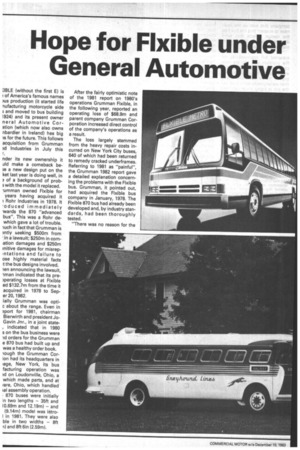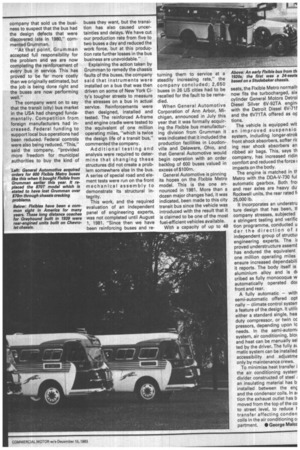Hope for Flxible under General Automotive
Page 70

Page 71

If you've noticed an error in this article please click here to report it so we can fix it.
:IBLE (without the first E) is 1 of America's famous names )us production (it started life iufacturing motorcycle side ; and moved to bus building 1924) and its present owner neral Automotive Coration (which now also owns nbardier in Ireland) has big is for the future. This follows acquisition from Grumman Industries in July this
nder its new ownership it ..11d make a comeback be;e a new design put on the ket last year is doing well, in .3 of a background of probwith the model it replaced. -umman owned Flxible for years having acquired it 1 Rohr Industries in 1978. It .oduced immediately wards the 870 "advanced bus". This was a Rohr dewhich gave a lot of trouble. luch in fact that Grumman is 3ntly seeking $500m from • in a lawsuit; $250m in cornation damages and $250m initive damages for misrepi-itati on s and failure to ose highly material facts t the bus designs involved.
• ten announcing the lawsuit, -.man indicated that its preverating losses at Flxible ed $132.7m from the time it acquired in 1978 to Seper 20, 1982.
ially Grumman was optic about the range. Even in vort for 1981, chairman Bierwirth and president JoGavin Jnr., in a joint state, indicated that in 1980 s on the bus business were
• Id orders for the Grumman e 870 bus had built up and was a healthy order book. mugh the Grumman Cor'on had its headquarters in ,age, New York, its bus facturing operation was
on Loudonville, Ohio, a which made parts, and at rare, Ohio, which handled ial assembly operation. 870 buses were initially 'n two lengths — 35ft and I 0.69m and 12.19m) — and (9.14m) model was intro1 in 1981. They were also ble in two widths — 8ft -1) and 8ft 6in (2.59m). After the fairly optimistic note of the 1981 report on 1980's operations Grumman Flxible, in the following year, reported an operating loss of $68.9m and parent company Grumman Corporation increased direct control of the company's operations as a result.
The loss largely stemmed from the heavy repair costs incurred on New York City buses, 640 of which had been returned to remedy cracked underframes. Referring to 1981 as "painful", the Grumman 1982 report gave a detailed explanation concerning the problems with the Flxible bus. Grumman, it pointed out, had acquired the Flxible bus company in January, 1978. The Flxible 870 bus had already been developed and, by industry stand a rds, had been thoroughly tested.
"There was no reason for the company that sold us the business to suspect that the bus had the design defects that were discovered late in 1980," commented Grumman.
"At that point, Grumman accepted full responsibility for the problem and we are now completing the reinforcement of every bus in service. This has proved to be far more costly than we originally estimated, but the job is being done right and the buses are now performing well."
The company went on to say that the transit (city) bus market in the USA had changed fundamentally. Competition from foreign manufacturers had increased. Federal funding to support local bus operations had been reduced. Federal controls were also being reduced. "This," said the company, "provided more freedom for municipal authorities to buy the kind of buses they want, but the transition has also caused uncertainties and delays. We have cut our production rate from five to two buses a day and reduced the work force, but at this production rate further losses in the bus business are unavoidable."
Explaining the action taken by Grumman to remedy the chassis faults of the buses, the company said that instruments were installed on a bus that was then driven on some of New York City's tougher streets to measure the stresses on a bus in actual service. Reinforcements were then designed, installed and tested. The reinforced A-frame and engine cradle were tested to the equivalent of one million operating miles, "which is twice the design life of a transit bus," commented the company.
Additional testing and analysis were required to determine that changing these structures did not create a problem somewhere else in the bus. A series of special road and element tests were run on the front mechanical assembly to demonstrate its structural integrity.
This work, and the required evaluation of an independent panel of engineering experts, was not completed until August 1, 1981. "Since then we have been reinforcing buses and re
turning them to service at a steadily increasing rate," the company concluded; 2,650 buses in 26 US cities had to be recalled for the fault to be remedied.
When General Automotive Corporation of Ann Arbor, Michigan, announced in July this year that it was formally acquiring the Flxible bus manufacturing division from Grumman it was indicated that it included the production facilities in Loudonville and Delaware, Ohio, and that General Automotive would begin operation with an order backlog of 600 buses valued in excess of $100m.
General Automotive is pinning its hopes on the Flxible Metro model. This is the one announced in 1981. More than a dozen major changes had, it was indicated, been made to this city transit bus since the vehicle was introduced with the result that it is claimed to be one of the most fuel-efficient vehicles available.
With a capacity of up to 48 seats, the Flxible Metro normalh now fits the turbocharged, six cylinder General Motors Detroi Diesel Silver 6V-92TA engini with the Detroit Diesel 6V-711' and the 6V71TA offered as or tions.
The vehicle is equipped wit an improved suspensio system, including longer-strok front shock absorbers, softer ric ing rear shock absorbers an ribbed air bags. This, says th company, has increased ridin comfort and reduced the force ( impacts on the body.
The engine is matched in th Metro with the DDA-V-730 ful automatic gearbox. Both frol and rear axles are heavy du. Rockwell units, the rear rated fi 25,000 lb.
It incorporates an understru ture design that has been, tt company stresses, subjected a stringent testing and verific tion programme, conducted u der the direction of z. independent group of structui engineering experts. The it proved understructure assernt has endured the equivalent one million operating miles ensure increased dependabili it reports. The body itself is aluminium alloy and is ch cribed as fully monocoque w automatically operated do( front and rear.
A fully automatic — with semi-automatic offered opt nally — climate control system a feature of the design. It utilit either a standard single, hea duty compressor, or twin cc pressors, depending upon lc needs. In the semi-automi system, air conditioning, blo‘ and heat can be manually sel ted by the driver. The fully at. matic system can be installed accessibility and adjustme only by maintenance crews.
To minimise heat transfer i the air conditioning system divider constructed of steel an insulating material has b installed between the en,c and the condensor coils. In al tion the exhaust outlet has b moved from the top of the co to street level, to reduce Itransfer affecting conden coils in the air conditioning ci partment. • George Malcc












































































































